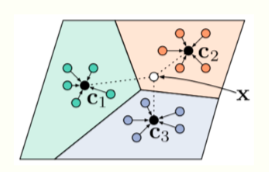少标签数据学习:宾夕法尼亚大学Learning with Few Labeled Data

原文链接 小样本学习与智能前沿 。 在这个公众号后台回复“200527”,即可获得课件电子资源。

Few-shot image classification
Three regimes of image classification

Problem formulation
Training set consists of labeled samples from lots of “tasks”, e.g., classifying cars, cats, dogs, planes . . .
Data from the new task, e.g., classifying strawberries has:

Few-shot setting considers the case when s is small.
A flavor of current few-shot algorithms
Meta-learning forms the basis for almost all current algorithms. Here’s one successful instantiation.
Prototypical Networks [Snell et al., 2017]
- Collect a meta-training set, this consists of a large number of related tasks
- Train one model on all these tasks to ensure that the clustering of features of this model correctly classifies the task
- If the test task comes from the same distribution as the meta-training tasks, we can use the clustering on the new task to classify new classes

How well does few-shot learning work today?

The key idea
A classifier trained on a dataset \(D_s\) is a function F that classifies data x using

The parameters \(θ^∗ = θ(D_s )\) of the classifier are a statistic of the dataset Ds obtained after training. Maintaining this statistic avoids having to search over functions F at inference time.
We cannot learn a good (sufficient) statistic using few samples. So we will search over functions at test-time more explicitly

Transductive Learning
 ## A very simple baseline
## A very simple baseline
- Train a large deep network on the meta-training dataset with the standard classification loss
- Initialize a new “classifier head” on top of the logits to handle new classes
- Fine-tune with the few labeled data from the new task
- Perform transductive learning using the unlabeled test data
with a few practical tricks like cosine annealing of step-sizes,
mixup regularization, 16-bit training, very heavy data augmentation, and label smoothing cross-entrop
An example

Results on benchmark datasets

The ImageNet-21k dataset

1-shot, 5-way accuracies are as high as 89%, 1-shot 20-way accuracies are about 70%.
A proposal for systematic evaluation

A thermodynamical view of representation learning
表征学习的热力学观点
Transfer learning
Let’s take an example from computer vision
(.Zamir, A. R., Sax, A., Shen, W., Guibas, L. J., Malik, J., & Savarese, S. Taskonomy: Disentangling task transfer learning. CVPR 2018)

Information Bottleneck Principle
信息瓶颈原则
A generalization of rate-distortion theory for learning relevant representations of data [Tishby et al., 2000]

Z is a representation of the data X. We want
- Z to be sufficient to predict the target Y , and
- Z to be small in size, e.g., few number of bits.

Doing well on one task requires throwing away nuisance information [Achille & Soatto, 2017].
The key idea
The IB Lagrangian simply minimizes \(I(X;Z)\), it does not let us measure what was thrown away.
Choose a canonical task to measure discarded information. Setting

i.e., reconstruction of data, gives a special task. It is the superset of all tasks and forces the model to learn lossless representations.
The architecture we will focus on is

An auto-encoder
Shanon entropy measures the complexity of data

Distortion D measures the quality of reconstruction

Rate R measures the average excess bits used to encode the representation

Rate-Distortion curve
We know that [Alemi et al., 2017]

this is the well-known ELBO (evidence lower-bound). Let

This is a Lagrange relaxation of the fact that given a variational family and data there is an optimal value R = func(D) that best sandwiches (1).

Rate-Distortion-Classification (RDC) surface
Let us extend the Lagrangian to

where the classification loss is

Can also include other quantities like the entropy S of the model parameters


The existence of a convex surface func(R,D,C,S) = 0 tying together these functionals allows a formal connection to thermodynamics [Alemi and Fischer 2018]

Just like energy is conserved in physical processes, information is conserved in the model, either it is in the encoder-classifier pair or it is in the decoder.
Equilibrium surface of optimal free-energy
The RDC surface determines all possible representations that can be learnt from given data. Can solve the variational problem for F(λ,γ) to get

and

This is called the “equilibrium surface” because training converges to some point on this surface. We now construct ways to travel on the surface
 The surface depends on data p(x,y).
The surface depends on data p(x,y).
An iso-classification loss process
A quasi-static process happens slowly enough for the system to remain in equilibrium with its surroundings, e.g., reversible expansion of an ideal gas.
We will create a quasi-static process to travel on the RDC surface. This constraint is

e.g., if we want classification loss to be constant in time, we need

……
更多精彩,请下载 资源文件 了解。
关注公众号“小样本学习与智能前沿”,回台回复“200527” ,即可获取资源文件“Learning with Few Labeled Data.pdf”

Summary
Simple methods such as transductive fine-tuning work extremely well for few-shot learning. This is really because of powerful function approximators such as neural networks.
The RDC surface is a fundamental quantity and enables principled methods for transfer learning. Also unlocks new paths to understanding regularization and properties of neural architecture for classical supervised learning.
We did well in the era of big data without understanding much about data; this is unlikely to work in the age of little data.
Email questions to pratikac@seas.upenn.edu Read more at
- Dhillon, G., Chaudhari, P., Ravichandran, A., and Soatto, S. (2019). A baseline for few-shot image classification. arXiv:1909.02729. ICLR 2020.
- Li, H., Chaudhari, P., Yang, H., Lam, M., Ravichandran, A., Bhotika, R., & Soatto, S. (2020). Rethinking the Hyperparameters for Fine-tuning. arXiv:2002.11770. ICLR 2020.
- Fakoor, R., Chaudhari, P., Soatto, S., & Smola, A. J. (2019). Meta-Q-Learning. arXiv:1910.00125. ICLR 2020.
- Gao, Y., and Chaudhari, P. (2020). A free-energy principle for representation learning. arXiv:2002.12406.
少标签数据学习:宾夕法尼亚大学Learning with Few Labeled Data的更多相关文章
- 【转载】 迁移学习(Transfer learning),多任务学习(Multitask learning)和端到端学习(End-to-end deep learning)
--------------------- 作者:bestrivern 来源:CSDN 原文:https://blog.csdn.net/bestrivern/article/details/8700 ...
- PU Learning简介:对无标签数据进行半监督分类
当只有几个正样本,你如何分类无标签数据 假设您有一个交易业务数据集.有些交易被标记为欺诈,其余交易被标记为真实交易,因此您需要设计一个模型来区分欺诈交易和真实交易. 假设您有足够的数据和良好的特征,这 ...
- 联邦学习(Federated Learning)
联邦学习简介 联邦学习(Federated Learning)是一种新兴的人工智能基础技术,在 2016 年由谷歌最先提出,原本用于解决安卓手机终端用户在本地更新模型的问题,其设计目标是 ...
- 零次学习(Zero-Shot Learning)入门(转)
很久没有更文章了,主要是没有找到zero-shot learning(ZSL)方面我特别想要分享的文章,且中间有一段时间在考虑要不要继续做这个题目,再加上我懒 (¬_¬),所以一直拖到了现在. 最近科 ...
- 小样本学习(few-shot learning)在文本分类中的应用
1,概述 目前有效的文本分类方法都是建立在具有大量的标签数据下的有监督学习,例如常见的textcnn,textrnn等,但是在很多场景下的文本分类是无法提供这么多训练数据的,比如对话场景下的意图识别, ...
- 【47】迁移学习(Transfer Learning)
迁移学习(Transfer Learning) 如果你要做一个计算机视觉的应用,相比于从头训练权重,或者说从随机初始化权重开始,如果你下载别人已经训练好网络结构的权重,你通常能够进展的相当快,用这个作 ...
- 多视图学习(multiview learning)
多视图学习(multi-view learning) 前期吹牛:今天这一章我们就是来吹牛的,刚开始老板在和我说什么叫多视图学习的时候,我的脑海中是这么理解的:我们在欣赏妹子福利照片的时候,不能只看45 ...
- 深度学习(Deep Learning)资料大全(不断更新)
Deep Learning(深度学习)学习笔记(不断更新): Deep Learning(深度学习)学习笔记之系列(一) 深度学习(Deep Learning)资料(不断更新):新增数据集,微信公众号 ...
- 读李宏毅《一天看懂深度学习》——Deep Learning Tutorial
大牛推荐的入门用深度学习导论,刚拿到有点懵,第一次接触PPT类型的学习资料,但是耐心看下来收获还是很大的,适合我这种小白入门哈哈. 原PPT链接:http://www.slideshare.net/t ...
随机推荐
- 分四个阶段学习python并找到一份好工作
第一阶段 关注公众号"轻松学编程"了解更多. 详细学习资料 需要时间一个月. 1.python概念 python是一种解释型.面向对象.动态数据类型的高级程序语言. 理解: ...
- Hash 哈希(上)
Hash 哈希(上) 目录 Hash 哈希(上) 简介 Hash函数的构造 取余法 乘积取整法 其他方法 冲突的处理 挂链法 开放定址法 线性探查法 二次探查法 双哈希法 结语 简介 Hash,又称散 ...
- Java的浅拷贝与深拷贝
Java的浅拷贝与深拷贝 Java中,所有的类都继承Object,Object中有clone方法,它被声明为了 protected ,所以我们但是如果要使用该方法就得重写且声明为public,必须在要 ...
- 学习笔记——make项目中克隆GitHub目录失败的解决
在示例项目中执行make后出现下面的错误 WARNING: Missing submodule components/json/cJSON... WARNING: Missing submodule ...
- 使用jQuery简单实现返回顶部的一个小案例
1.简单写一个页面 首先我们应该创建两个盒子,container盒子主要模拟页面滚动到的位置,back盒子主要功能是实现返回顶部的功能 2.简单的对这两个盒子写一些样式 我们应该先将返回顶部盒子隐藏( ...
- 为什么删除的Ceph对象还能get
前言 在很久以前在研究一套文件系统的时候,当时发现一个比较奇怪的现象,没有文件存在,磁盘容量还在增加,在研究了一段时间后,发现这里面有一种比较奇特的处理逻辑 这套文件系统在处理一个文件的时候放入的是一 ...
- 查看ceph集群被哪些客户端连接
前言 我们在使用集群的时候,一般来说比较关注的是后台的集群的状态,但是在做一些更人性化的管理功能的时候,就需要考虑到更多的细节 本篇就是其中的一个点,查询ceph被哪些客户端连接了 实践 从接口上来说 ...
- backfill和recovery的最优值
ceph在增加osd的时候会触发backfill,让数据得到平均,触发数据的迁移 ceph在移除osd的时候需要在节点上进行数据的恢复,也有数据的迁移和生成 只要是集群里面有数据的变动就会有网卡流量, ...
- linux下制作软件包安装服务器
linux下的软件包在有网络的情况下比较好安装,在ubuntu下,更新sourcelist,然后使用apt-get就可以很方便的安装包,在centos下面,更新yum列表,然后使用yum也可以进行方便 ...
- nginx开启目录浏览
使用nginx作为下载站点,开启目录浏览的功能 在/etc/nginx/sites-enabled/default中添加: autoindex on ; autoindex_exact_size of ...
